Our first view of Greenland as we enter Prince Christian Sound.
The sound is about 60 miles (100 km) long and narrow, some places 1000 ft (500 meters) wide.
It is a fjord that separates the main island of Greenland from a cluster of islands at its southern end.
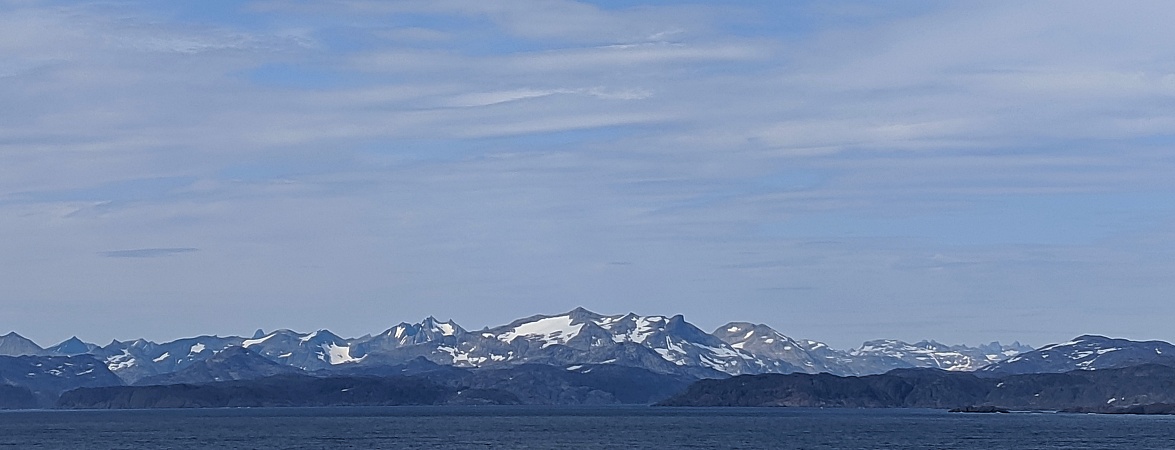
A few minutes later we saw this Sprite onboard the ship.
During our transit she was joined by other creatures that apparently inhabit this area.
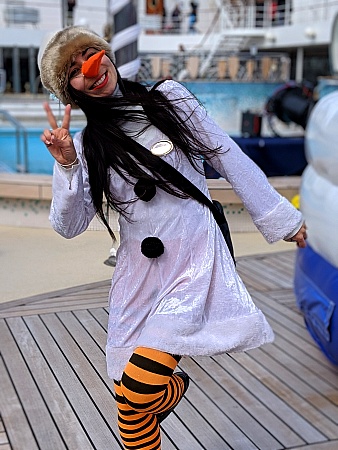
Some shots as we cruised along
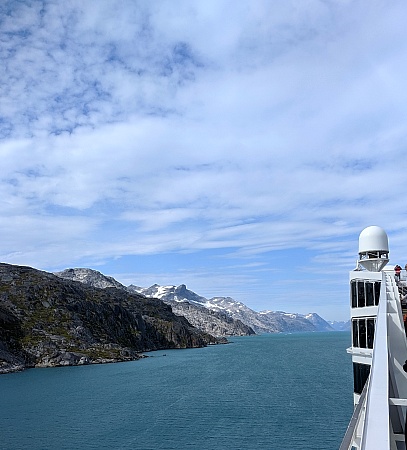
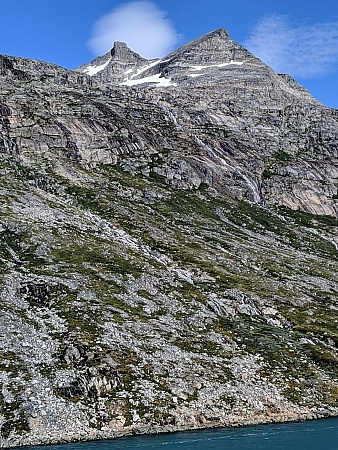
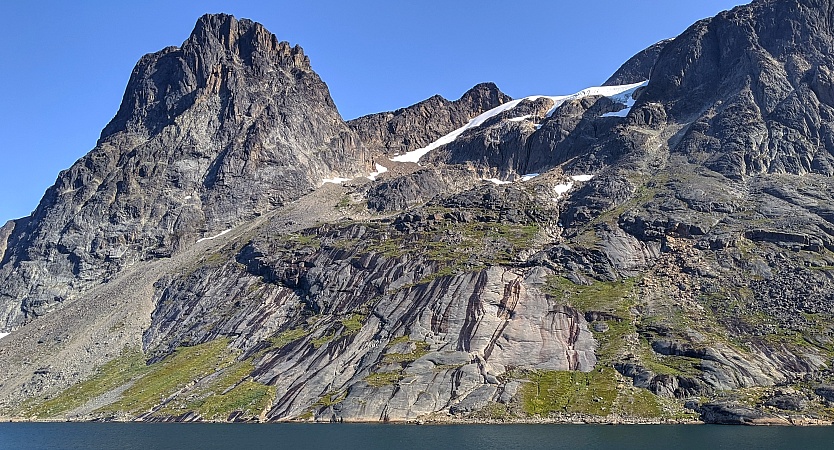
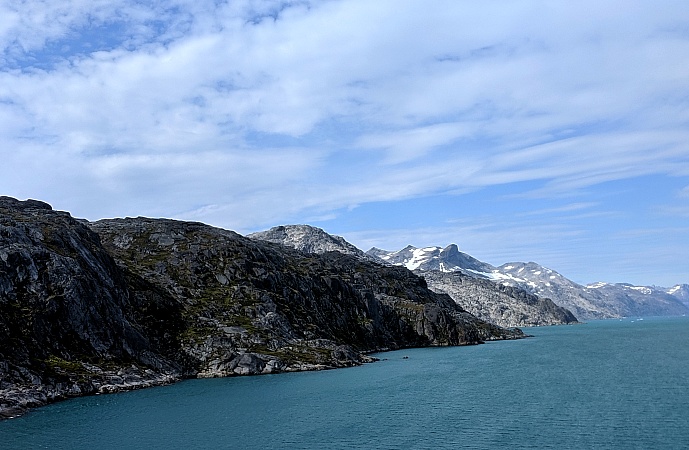
And off the stern
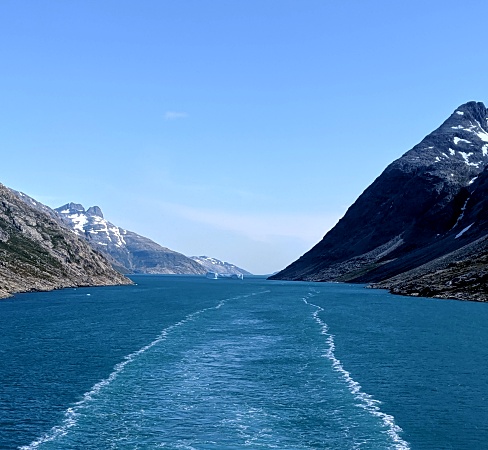
Occasional icebergs we passed meant that the captain had to keep the speed down.
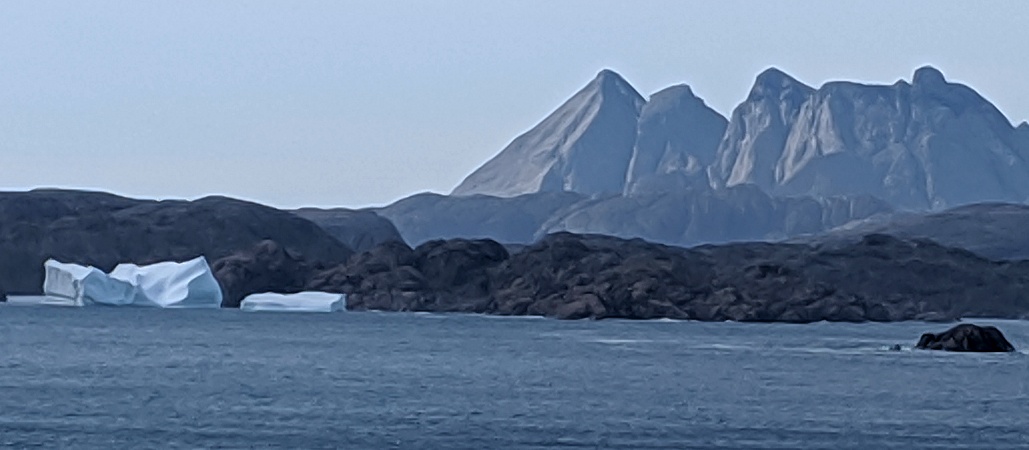
One of the glaciers that empty into the fjord and produce those icebergs.
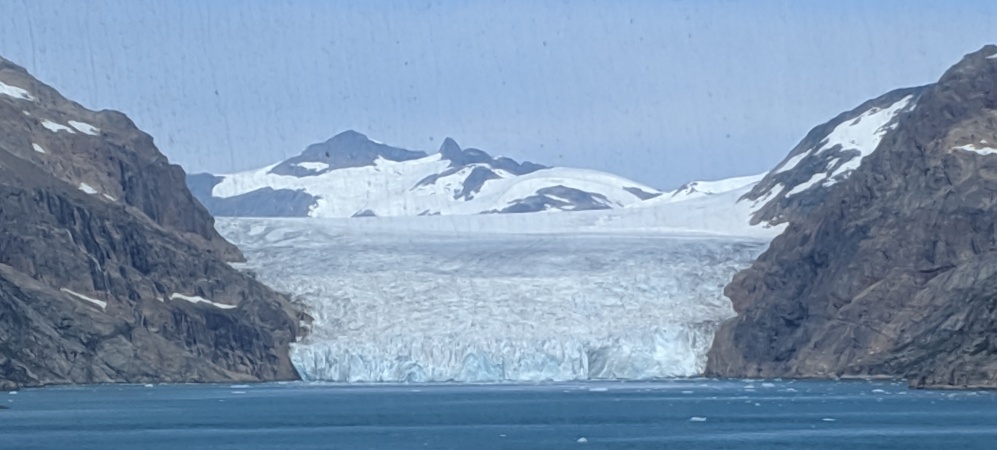
Another of those creatures that came on board
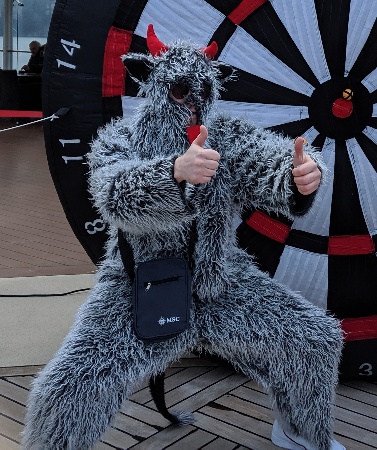
This explains it.
The arctic cousin of Poseidon and his entourage were here to welcome us.
He presented a symbolic key for all those onboard the ship
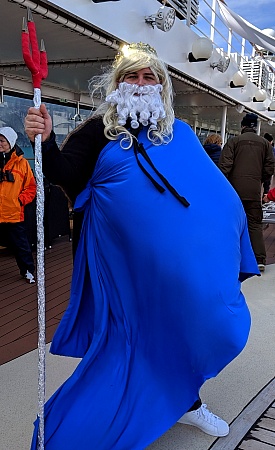
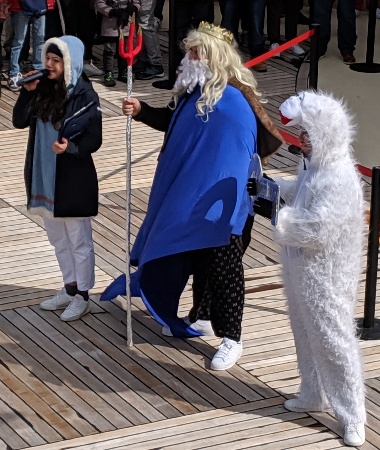
This sculpture was being carved from a chunk of ice from a glacier that had been picked up from the fjords.
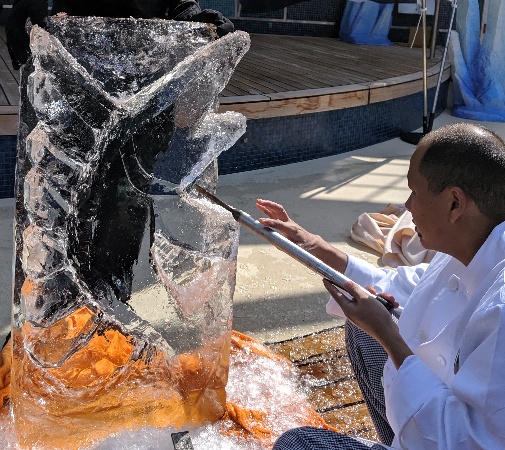
More sights along the way.
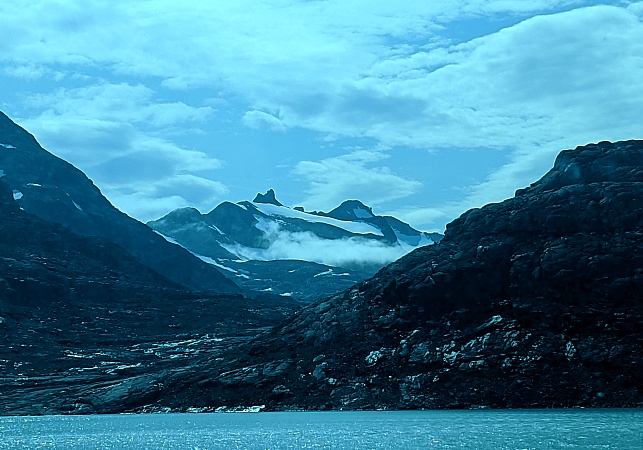
Another glacier,
This one has what appears to be a cave at water level.
We got a close up view of this iceberg.
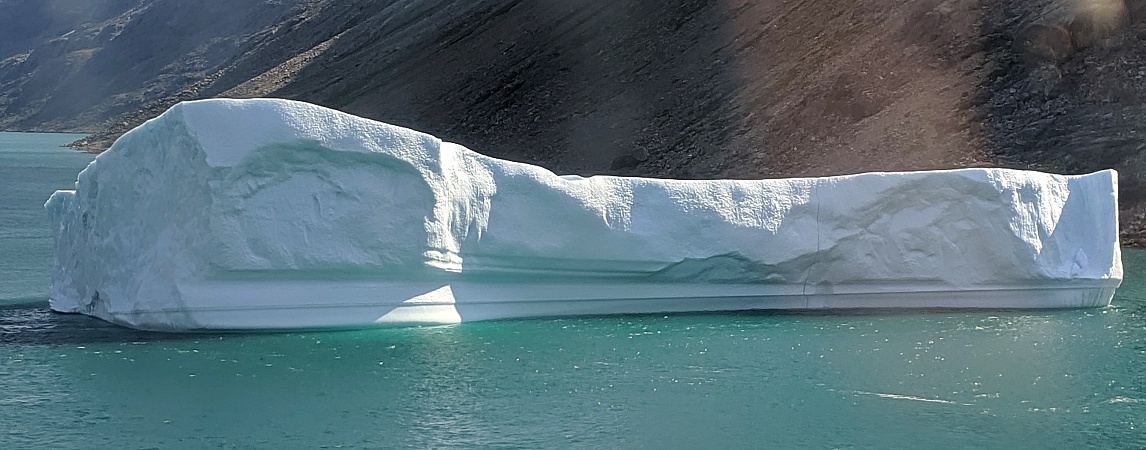
And as we pulled away
What's this, another ship?
Yep!
Aappilattoq, also known as Rødførdeis a community of about 100 hearty folks.
And just beyond.
Then up along the western coast to the three towns where we stopped.
Qaqortoq
The southernmost town we visited in Greenland.
This is what we saw as we came into the harbor.
And as we came ashore
The population is about 3000.
.
Rock carving artwork is all over the place.
We climbed up the hillside to get a different view of the well kept town.
At the base of the hill was this little stream.
Along the stream near the center of the town is the Church of Our Savior Lutheran church.
And next to it is a tiny chapel.
Beside the church is a stone marker commemorating missionaries Hans Egede and his wife Gertrud Rask
They arrived in Greenland in 1721 to establish a colony and Christianize the Inuit people.
Continuing through the town we found some really fresh fish and dried fish as well for sale.
More art, this time a sculpture of The Qaqortoq Maiden, also known as "Sassuma Arnaa," mother of the sea.
Just wandering around we found another Lutheran church this one named the Hans Egede Church.
Other places just to give you a taste of what the town is like.
This fountain near the stream.
We tried some local beer.
The tables were inlaid with a map of Greenland and pictures of hunters/fishermen.
And a snack.
The museum is housed in the town’s oldest building, a black-tarred colonial administrator’s building which was built in1804
Surreal artworks
Model showing summer clothing and hut
Soapstone pots and lamps, a toy dog sled showing how the dogs were harnessed, and a toy kayak
Surreal walrus ivory carvings
And more realistic ones.
Household artifacts.
A walrus skull.
Kayaks showing their frames, what they carried on hunting trips and how the frames were tied together with leather thongs.
I found that I couldn't write a summary of this display that did it justice so I am including it in its entirety.
This painting depicts scenes of Inuit life, including hunting, fishing, and daily activities, against a backdrop of the Arctic landscape. It showcases traditional tools, clothing made of sealskin, and methods of transportation, offering a glimpse into the cultural heritage and environment of South Greenland.
Outside along the waterfront were kayaks and fishing boats.
Some really local beer produced in a microbrewery and a fine restaurant.
Its products, very enjoyable.
And on a beam over the dining room was the world's longest word in Greenlandic: 153 letters
Nalunaarasuartaateeranngualioqatigiiffissualioriataallaqqissupilorujussuanngortartuinnakasinngortinniamisaalinnguatsiaraluallaqqooqigaminngamiaasiinngooq
Which means the following:
“Although I have tried to turn the report into a very large number of companies cool that the condescending guy knows too many times had considered whether, despite my poor condition can still be considered to be quite adept and resourceful as the initiator to put a consortium on its feet for there was that they know for how many times - once again had considered to put together a network of small radio stations, even though it is still only on the drawing board”
Or something like that.
Nuuk
The capital of Greenland is not large, population about 20,000, but it is full of welcoming folks.
Here is a bit of what we saw as we drove through the town.
Artwork was everywhere.
We visited the home of a resident who offered treats and entertained us with song
Click her picture for a video.
Use the back arrow on your browser to return to this page.
Here are some of the items she had as decorations.
Downtown.
More of the art I mentioned earlier.
And a workshop where glass work and other projects were made.
I couldn't resist a picture of these kids out for a walk.
Church of our Saviour, a wooden Lutheran cathedral in the Old Nuuk neighborhood.
In Greenland you might expect kayaks.
And since we were by the shore an appropriate statue.
This is The Mother of the Sea on the Nuuk waterfront near the National Museum.
It depicts the Greenlandic legend of a shaman combing the goddess' hair to release all the fish and animals for fishermen and hunters.
Outside the National museum are this pair of presses once used to extract oil from whale blubber.
Inside the museum we saw these fancy outfits.
And a reproduction of an early resident's cabin with some of what they had to eat.
The framework of a kayak.
It must have been hard to find the wood to build it.
Native costumes from the 1470s.
The text details of how they took advantage of the natural insulating/protective properties.
Artifacts on display.
Most of the white figures are carved walrus tusks.
A reproduction of a hunter's shelter with some of the items they would need to survive.
The tripod supports a shallow bowl that may have held oil and a wick for light.
A workshop with the tools needed to craft barrels to transport whale oil.
And as we were waiting this dancer suddenly appeared and did a good job of frightening some of those present.
Click on the larger picture for a video.
Use the back arrow on your browser to return to this page.
Outside were folks with brighter smiles that seemed a lot more friendly.
Ilulissat
The northernmost town we visited in Greenland.
It is 155 miles (250 km) north of the Arctic circle.
A fishing boat in the harbor.
As we went ashore we passed through the jawbones of a whale.
A view of the town.
This rock face records some of the extreme forces that have shaped the island.
If you know how to interpret it.
We were cautioned to not approach these pups and young dogs..
They are not pets but will soon be in training to be sled dogs and even as cute as they are, they shouldn't be trusted.
The town is known for the Ilulissat Icefjord UNESCO World Heritage Area.
The fjord is 25 mi (40km) long and is covered with icebergs over nearly all of it's length.
It is fed from the Jakobshavn Glacier glacier that is part of the Greenland ice sheet and is responsible for about 10% of all the icebergs originating from Greenland.
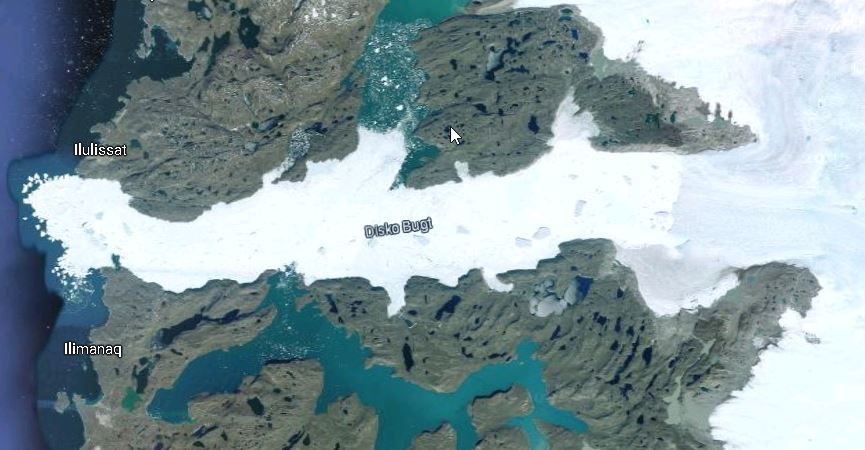
A composite view from Google maps of about 20 mi (32 km) of the fjord.
The pictures were taken at different times of the year and shows how the density of icebergs varies depending on the weather.
We walked about 2 mi (3.2 km) on a trail along the north side.
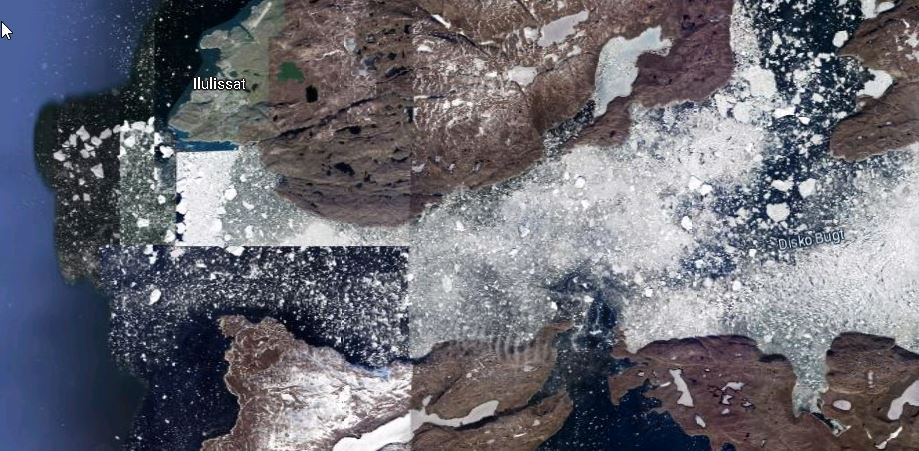
This was our first view of the fjord of icebergs.
And I stepped back to get a couple of wider shots.
Down closer to the "shore".
Some little depressions gave enough cover for vegetation to take hold.
And Nancy took some pictures of them.
You can see some of the plants we saw here.
The blue rocks mark a trail that we crossed.
This ice is black because of rock dust and stones scraped from the sides and bottom of the glacier and then churned to the surface as it broke up into icebergs.
More random pictures along the fjord.
Watch your step!
Note, there are no safety barriers.
They assume that their visitors have some sense about the common natural hazards.
Yep, we were there.
This part of the trail was a boardwalk to protect the vegetation.
A little rocky beach did warrant a warning sign since they didn't expect everyone to recognize a unique hazard they have.
This boater seems to be ignoring it though.
A cairn marking one of the trails.
Back in town we stopped for a little refreshment.
We always ask for the local beer when we are traveling and have never been disappointed.
The label lists the ingredients as only "Glacial water, Malted barley, Hops, and Yeast".
Stronger stuff was available but not local.
The cemetery just outside of town.
Nikolaj Isak Jørgen Brønlund was a Greenlandic teacher, dog sled driver and polar explorer.
He was a childhood friend of the Danish arctic explorer Knud Rasmussen.
And joined him on the Greenland Expedition to Thule in the period 1902 to 1904.
He also participated as one of the few Greenlanders in Mylius-Erichsen's Denmark expedition.
He died at the depot Lamberts Land of hunger and frostbite.
And once again it is time to re board our ship to travel to our next adventure.
Looking back along the coast.
